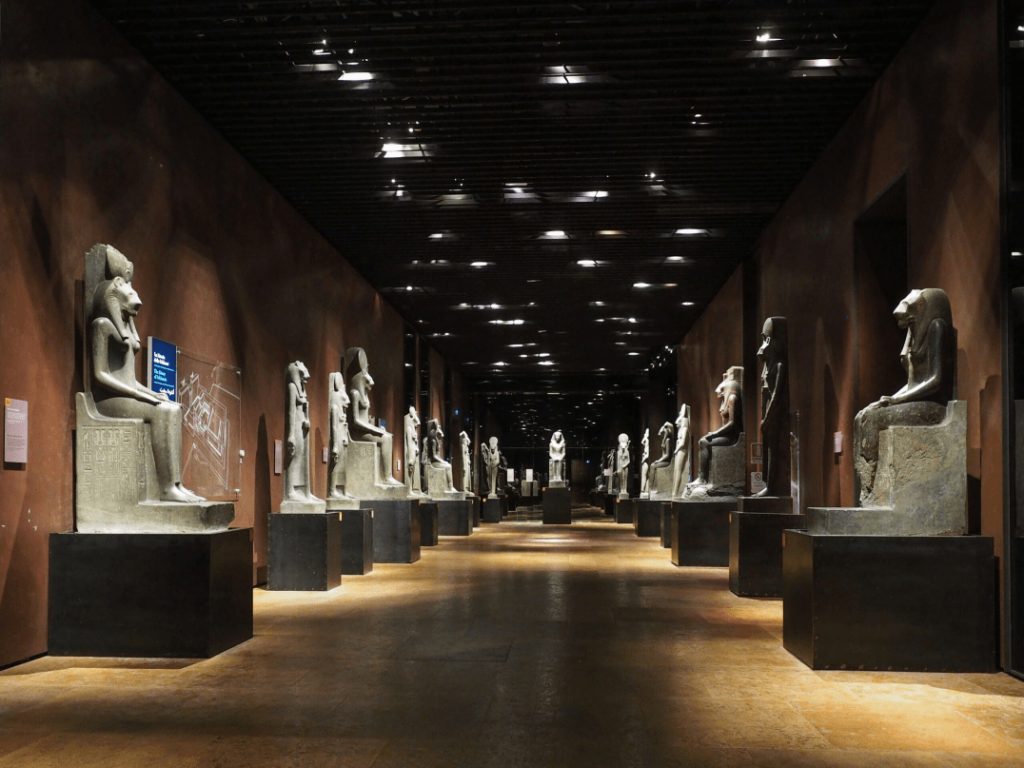The National Museum of Egyptian Civilization (NMEC) stands as a beacon of Egypt’s rich history, offering a comprehensive journey through its millennia-old heritage. Located in the historic city of Fustat, Cairo, this museum is more than just a repository of artifacts; it’s a vibrant cultural and educational center designed to engage visitors of all ages. For learners of Arabic, it offers a fascinating glimpse into the country’s past while providing an accessible way to connect with Egyptian culture.
What is the National Museum of Egyptian Civilization?
The National Museum of Egyptian Civilization (NMEC) is the first museum of its kind in Egypt and the Arab world, presenting the full spectrum of Egyptian civilization. From prehistoric times to the modern era, the museum showcases the continuity and diversity of Egypt’s tangible and intangible heritage. It aims to be a leading cultural, scientific, and research institution dedicated to preserving and sharing Egypt’s legacy.
Discovering Egyptian Civilization at NMEC
The museum houses an impressive collection of approximately 50,000 artifacts, meticulously curated to tell the story of Egypt through various historical periods. The exhibition spaces are thoughtfully designed, dividing the vast history into chronological and thematic galleries.
The Royal Mummies Gallery: A Highlight of the National Museum of Egyptian Civilization Photos
One of the most captivating sections of the National Museum of Egyptian Civilization is the Royal Mummies Gallery. This unique display uses cutting-edge 21st-century technology to reveal the secrets of ancient mummification. Visitors can explore interactive exhibits that shed light on the rituals, religious beliefs, and scientific processes surrounding mummification in ancient Egypt. The parade of 22 royal mummies from the Egyptian Museum in Tahrir to NMEC in April 2021 was a monumental event, bringing global attention to the museum and its magnificent collection. These National Museum of Egyptian Civilization photos of the mummies are among the most sought after by visitors.
Main Galleries and Thematic Displays
Beyond the Royal Mummies, NMEC’s main galleries take you on a journey through different eras:
- Chronological Periods – العصور الزمنية :
- Pre-Dynastic and Early Dynastic Periods – عصر ما قبل الأسرات والعصر المبكر
- Pharaonic Period – العصر الفرعوني
- Greco-Roman Period – العصر اليوناني الروماني
- Coptic Period – العصر القبطي
- Islamic Period – العصر الإسلامي
- Modern and Contemporary Periods – العصر الحديث والمعاصر
- Thematic Topics – الموضوعات :
- Dawn of Civilization – فجر الحضارة
- The Nile – النيل
- Writing – الكتابة
- State and Society – الدولة والمجتمع
- Material Culture – الثقافة المادية
- Beliefs and Thinking – المعتقدات والفكر
Other Notable Exhibits
- Textile Hall – قاعة النسيج : Showcasing the evolution of Egyptian textiles.
- Ancient Dye House – بيت الصباغة القديم : Providing insights into ancient dyeing techniques.
Planning Your Visit to the National Museum of Egyptian Civilization
Location
The museum is conveniently located in El-Fustat Road, Ein Elsira, Cairo. The closest metro station is Mar Gerges.
Opening Hours
The National Museum of Egyptian Civilization is open daily.
- Saturday – Thursday: 9:00 AM – 5:00 PM (Last ticket admission at 4:00 PM)
- Friday: 9:00 AM – 5:00 PM (Last ticket admission at 4:00 PM) and 6:00 PM – 9:00 PM (Last ticket admission at 8:00 PM)
Ticket Prices
- Foreigners – الأجانب :
- الكبار (Adults): 500 EGP
- الطلاب (Students): 250 EGP
- Egyptians – المصريون :
- الكبار (Adults): 80 EGP
- الطلاب (Students): 40 EGP
Facilities and Services
The museum offers a range of facilities to enhance your visit:
- Cinema Theater
- Meeting Room
- Lecture Hall
- Roman Theater for events
- Gift Shop
- Café
- Ramped Entrance, Toilets, Parking, Elevator, ATM
- Educational programs for children, including workshops and tailored tours.
Why Visit The National Museum of Egyptian Civilization?
Visiting the National Museum of Egyptian Civilization is an unparalleled opportunity to immerse yourself in the grandeur of Egypt’s past. It’s a place where history comes alive through innovative displays and a vast collection of artifacts. Whether you’re a history enthusiast, an Arabic language learner, or simply looking for an engaging cultural experience, NMEC promises an unforgettable journey through the heart of Egyptian civilization.
Conclusion
The National Museum of Egyptian Civilization is a monumental achievement, showcasing Egypt’s enduring legacy from ancient times to the present. With its state-of-the-art facilities, diverse collections, and commitment to education, it stands as a testament to the richness and continuity of Egyptian civilization. Make sure to include it in your travel plans to Cairo and experience the magic of Egyptian history firsthand.
If you want to learn more about Arab culture, visit our blog on www.kaleela.com and don’t forget to download the Kaleela app to learn Egyptian dialect.



